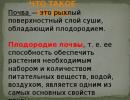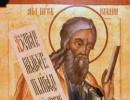Presentation on the history of 17th century architecture. Presentation on the MHC "Architecture of Russia in the 17th century"
Description of the presentation by individual slides:
1 slide
Slide description:
Architecture of Russia in the 17th century The project was completed by an 11th grade student of the Municipal Educational Institution “Secondary School No. 3” in the city of Rzhev, Tver Region, Ilya Smirnov, MHC Teacher M.A. Alexandrova
2 slide
Slide description:
Purpose of the work: to tell about the architecture of Russia of the 17th century, the forms, features and styles of buildings of that period
3 slide
Slide description:
In Russian architecture of the 17th century, as in other spheres of cultural life in Russia at that time, secular motifs began to dominate. The architecture of the 17th century began to move away from medieval simplicity and austerity. Russian architecture of the 17th century is interesting, first of all, for its decorativeness. Beautiful relief platbands decorate the windows of buildings, stone cutting makes the buildings unusually quaint and picturesque. Tiles give the buildings of Russian architecture of the 17th century their multicolored appearance.
4 slide
Slide description:
One of the most popular architectural forms of the 17th century is the tent. The refectory church of the Alekseevsky Monastery in Uglich is a striking example of this architectural form. Three slender tents rise above the heavy volume of the refectory. The tents are located on the vaults of the church, and are not associated with its spatial structure.
5 slide
Slide description:
In the further development of Russian architecture of the 17th century, the tent turns from a structural element into a decorative one. The tent becomes a characteristic architectural element of the 17th century for small town churches. The best example of 17th century architecture of this kind is the Moscow Church of the Nativity of the Virgin. The church is located in Putinki.
6 slide
Slide description:
The construction of the church began by local parishioners who wanted to surprise Moscow with unprecedented wealth and beauty. However, they did not calculate their strength and had to ask the king for help. Alexey Mikhailovich gave a huge sum from the state treasury for the construction of the temple. The temple turned out very good indeed. The Church of the Birth of the Virgin Mary is the last tented church in Moscow. In 1652, Patriarch Nikon forbade the construction of churches made in the hipped architectural style.
7 slide
Slide description:
In the architecture of the 17th century, in the construction of temples, not only the tented architectural style was used, but also others. Pillarless cubic temples (ships) were popular. In the last quarter of the 17th century, the Moscow Baroque style became widespread in Russian architecture. Sometimes it is called “Naryshkinsky” baroque, this name comes from the name of the main customer. This style in the 17th century was characterized by order details, the use of red and white colors in the painting of buildings, and the number of storeys in buildings. Gate churches, the refectory and bell towers of the Novodevichy Convent, the Church of the Intercession in Fili, churches and palaces in Sergiev Posad were built in this architectural style.
8 slide
Slide description:
In Russian architecture of the 17th century, stone construction became available not only to the royal family. The wealthy boyars and merchants are now able to build themselves “Stone Mansions.” Moscow and the provinces know many stone buildings of noble and wealthy families. Stone construction predominates in 17th century architecture.
Slide 1
Architecture of the 17th century in Russia Prepared by 7th grade student “A” Gurevich Sofya, history teacher Martynenkova M.V.Slide 2
 As in other areas of culture, in architecture there was a gradual departure from strict church canons and traditions. Attitudes towards religion changed, ties with Europe strengthened, and new styles emerged in architecture. It was during this period that the transition of architecture from the strict forms of the Middle Ages to decorativeness, from the church to the secular was noticed. This was manifested, in particular, in the desire for external elegance, described by contemporaries as “wonderful patterns.” Carved platbands, stone cuttings, and multi-colored tiles appear on the facades of buildings. At the beginning of the 17th century, the construction of tent compositions, which began in the 16th century, continued. One of the striking examples of that era is the Wonderful Assumption Church on the territory of the Alekseevsky Monastery in Uglich.
As in other areas of culture, in architecture there was a gradual departure from strict church canons and traditions. Attitudes towards religion changed, ties with Europe strengthened, and new styles emerged in architecture. It was during this period that the transition of architecture from the strict forms of the Middle Ages to decorativeness, from the church to the secular was noticed. This was manifested, in particular, in the desire for external elegance, described by contemporaries as “wonderful patterns.” Carved platbands, stone cuttings, and multi-colored tiles appear on the facades of buildings. At the beginning of the 17th century, the construction of tent compositions, which began in the 16th century, continued. One of the striking examples of that era is the Wonderful Assumption Church on the territory of the Alekseevsky Monastery in Uglich.
Slide 3
 In later construction, the tent ceases to be a structural element and begins to serve more of a decorative function. It can be seen on small churches and secular buildings of that era. The last tent-type temple is the Moscow Church of the Birth of the Virgin Mary in Putinki, dating back to the mid-17th century. The fact is that it was during this period that the church, led by Patriarch Nikon, recognized many old church dogmas as erroneous, and a ban was imposed on the construction of tented cathedrals and churches. From now on, they had to be five-headed and with crowns. In addition to the tented ones, in the 17th century they also built pillarless cubic cathedrals and churches, also called ships, as well as round temples. The first pillarless temple is Uglich. Church of John the Baptist
In later construction, the tent ceases to be a structural element and begins to serve more of a decorative function. It can be seen on small churches and secular buildings of that era. The last tent-type temple is the Moscow Church of the Birth of the Virgin Mary in Putinki, dating back to the mid-17th century. The fact is that it was during this period that the church, led by Patriarch Nikon, recognized many old church dogmas as erroneous, and a ban was imposed on the construction of tented cathedrals and churches. From now on, they had to be five-headed and with crowns. In addition to the tented ones, in the 17th century they also built pillarless cubic cathedrals and churches, also called ships, as well as round temples. The first pillarless temple is Uglich. Church of John the Baptist
Slide 4
 The popularization of stone buildings, which began in the 16th century, continues. In the 17th century, such construction no longer became only the privilege of kings. Now boyars and merchants could build stone mansions for themselves. Many residential stone houses were built in the 17th century both in the capital and in the provinces. But the kings, as it turned out, on the contrary, preferred wooden architecture. Despite the widespread use of stone as the main building material, the 17th century can rightfully be considered the heyday of Russian wooden architecture. The royal palace in Kolomenskoye was considered a masterpiece of wooden architecture and architecture of the 17th century. At that time, the residence had 270 rooms and about 3,000 windows. Unfortunately, in the mid-18th century it was dismantled due to disrepair on the orders of Empress Catherine II. In our time, it has been recreated from records and drawings, allowing one to judge the beauty and grandeur of the architecture of that time, but in this form it no longer represents the same architectural value as if it were the original. The Tsar's Palace in the 17th century The Tsar's Palace now
The popularization of stone buildings, which began in the 16th century, continues. In the 17th century, such construction no longer became only the privilege of kings. Now boyars and merchants could build stone mansions for themselves. Many residential stone houses were built in the 17th century both in the capital and in the provinces. But the kings, as it turned out, on the contrary, preferred wooden architecture. Despite the widespread use of stone as the main building material, the 17th century can rightfully be considered the heyday of Russian wooden architecture. The royal palace in Kolomenskoye was considered a masterpiece of wooden architecture and architecture of the 17th century. At that time, the residence had 270 rooms and about 3,000 windows. Unfortunately, in the mid-18th century it was dismantled due to disrepair on the orders of Empress Catherine II. In our time, it has been recreated from records and drawings, allowing one to judge the beauty and grandeur of the architecture of that time, but in this form it no longer represents the same architectural value as if it were the original. The Tsar's Palace in the 17th century The Tsar's Palace now
Slide 5
 By the end of the 17th century, a new style appeared in Russian cathedral architecture, called Naryshkin or Moscow baroque. The style got its name from the name of the main customer. This style corresponds to the combination of white and red colors in the painting of building facades and the number of floors of buildings. Examples of buildings in this style are the churches and palaces of Sergiev Posad, the Church of the Intercession in Fili, bell towers, the refectory and gate churches in the Novodevichy Convent. Church of the Intercession in Fili
By the end of the 17th century, a new style appeared in Russian cathedral architecture, called Naryshkin or Moscow baroque. The style got its name from the name of the main customer. This style corresponds to the combination of white and red colors in the painting of building facades and the number of floors of buildings. Examples of buildings in this style are the churches and palaces of Sergiev Posad, the Church of the Intercession in Fili, bell towers, the refectory and gate churches in the Novodevichy Convent. Church of the Intercession in Fili
Slide 6
 A large number of secular buildings have survived to our times, allowing us to judge the architecture of that time. These are the wooden Kremlin towers, the Krutitsky tower and the Golitsyn house in Moscow, the stone Pogankin chambers in Pskov, like many buildings of that era, indicating the high degree of whimsical tastes that reigned in the architecture of the 17th century. Golitsyn House
A large number of secular buildings have survived to our times, allowing us to judge the architecture of that time. These are the wooden Kremlin towers, the Krutitsky tower and the Golitsyn house in Moscow, the stone Pogankin chambers in Pskov, like many buildings of that era, indicating the high degree of whimsical tastes that reigned in the architecture of the 17th century. Golitsyn House
Slide 1
17th century architecture
Slide 2

17th century architecture
The Time of Troubles contributed to the loss of stone art skills. The temples of the 17th century were more massive, simpler and rougher than the temples of the 16th century. Russian art of the 17th century. strikes with its exceptional combination of strict adherence to the established Orthodox tradition with the activity of new tastes and renewal of artistic techniques.
Slide 3

Tent (tent style) in wooden and stone architecture of the 16th-18th centuries. completion of buildings in the form of a high tetrahedral or polyhedral pyramid.
Slide 4

Tent style
Typological options for tented temples: An octagon on a quadrangle (cruciform or cubic) A tent on a quadrangle without an octagon An octagonal temple without a quadrangle Composition of several tent-roofed aisles Tent-shaped churches were erected according to the orders of the kings, built in royal villages and on the estates of noble people.
Slide 5

MERCHANT TEMPLES
Slide 6

“Wonderful pattern” - this is the name of one of the most beautiful pages of Moscow architecture of the 17th century
Built in 1628-1651. By order of the merchant Grigory Nikitnikov, on the site of the Church of St. Nikita the Martyr “on Glinishchi” that burned down in 1626, the temple was erected next to the courtyard of G. Nikitnikov.
In 1904 in the basement of the central quadrangle, a chapel was built in the name of the Georgian Mother of God, whose icon (1654) was kept in the temple, which is why the Trinity Church was sometimes called the Church of the Georgian Mother of God.
Slide 7

Moscow Trinity Church in Nikitniki
The entrance to the church is decorated with a tented porch (for the first time in church architecture). The similarity of the decorative forms of the porch, the covered gallery, the platbands of the two main windows of the southern facade and the internal portals of the church to the decor of the Kremlin Terem Palace (1635-1636) and its Upper Golden Porch suggests that not all elements of this complex temple complex were built at the same time.
Slide 8

The inside of the church is cozy. There are no pillars, a lot of light pours in from the large windows, and the space lies light and calm. Colorful paintings cover the walls with a continuous carpet.
Slide 9

Church of the Nativity of the Virgin Mary
Another interesting monument of the first half of the 17th century is the Church of the Nativity of the Virgin Mary, “in Putinki”. During the three years of construction, from 1649 to 1652, the plans of the customers expanded, and the temple was replenished with more and more new premises.
Slide 10

In the last quarter of the 17th century, the type of Moscow parish church with a quadrangle of the main volume and a five-domed structure, a hipped bell tower and a one-story refectory was finally formed. This is the Church of St. Nicholas in Khamovniki (1676-1682). Its name is due to the settlement of weavers, or Khamovniki, located here in the 17th century.
St. Nicholas Church in Khamovniki
The temple is beautiful with its upward direction and orderliness of details. The impression of richness and patterning is achieved thanks to the red-green coloring of the decorative details, which clearly stand out against the white background of the wall.
Slide 11

Spaso-Andronnikov Monastery
The Spaso-Andronnikov Monastery was founded in 1359 on the steep bank of the Yauza River on the road from young Moscow to Vladimir. It was named after its first abbot Andronik, a student of Sergius of Radonezh. In 1425-1427 A large stone Spassky Cathedral is being built in the monastery. The great Russian icon painter Andrei Rublev took part in its creation.
The cathedral amazes with its original appearance. The walls of the temple are decorated with strict blades, high stairs rise to the portals, and the top is very complex - it consists of multi-tiered zakomaras, echoing the keel-shaped ends of the portals. The lateral divisions of the facades with the same keel-shaped zakomaras are much lower. This enhances the vertical dynamics of the building. Even higher is the second tier of zakomaras, forming a crown at the base of the head. It is not for nothing that this temple was already endowed with the epithet “very red” in ancient times.
Slide 12

Novodevichy Convent.
It was founded at the beginning of the 16th century both as a monument to the liberation of Smolensk and as a fortress guarding the approaches to the capital from the southwest.
Slide 13

The main buildings that glorified the monastery were erected in the 80s of the 17th century with the active participation of Princess Sofia. The main buildings are built along the central axis (from west to east) - the refectory, the cathedral, and to the east of it - the bell tower. To the south and north of the cathedral, gate multi-domed churches were erected - Preobrazhenskaya and Pokrovskaya. They are located on a three-bay arched base - a kind of triumphal arches.
Slide 14

Smolensky Cathedral
In 1524-1525 a grandiose five-domed cathedral was built here, modeled on the Kremlin Assumption Cathedral. However, the architect changed the ratio of the width and height of the walls, made a basement, which does not exist in the Kremlin, and placed the domes closer together. This gave the cathedral dynamism.
Slide 15

Temple of the Ascension in Kolomenskoye
In 1532, the famous Church of the Ascension was erected here, which began the construction of stone tented churches. On the high bank of the Moscow River, the white pillar of the Kolomna Church rises into the sky, consisting of a mighty cross-shaped base and a uniquely shaped tent, crowned with a small dome. Slender pilasters at the corners of the building, sharp “arrows” sandwiched in the piers, triple tiers of keel-shaped kokoshniks - everything rushes upward.
Slide 16

The courage and beauty of the Kolomna Church of the Ascension amazed the people of Ancient Rus'. “That church was wonderful in its height, beauty and lightness, as if nothing had happened before in Rus',” the chronicler wrote in the year the construction of the temple was completed. On the eastern side of the walkway surrounding the temple, there is a throne made of white stone. From here, the Moscow kings admired the width of the river, its meadows and forests blue on the horizon.
Slide 17

Construction ban
In the middle of the 17th century, the development of hipped-roof architecture was suspended by the decrees of Patriarch Nikon. Thus, in one of the temple charters, Patriarch Nikon commanded to build churches: “According to the order of the correct and statutory law, as the rule and the church charter commands, to build with one, with three, with five domes, and not to build tent churches at all...”
Slide 18

Moscow Baroque is the conventional name for the style of Russian architecture of the last decades of the 17th century - the first years of the 18th century, the main feature of which is the widespread use of elements of the architectural order and the use of centric compositions in temple architecture.

The architecture of the 17th century continued to develop the techniques of the previous period, but was distinguished by increased decorativeness of forms, an even greater variety of motifs than before, and the active use of plastic details and color in the external and internal appearance of buildings. Construction continued to expand, both civil and religious. Large residential houses of boyars and merchants, palace complexes are being built

Of all the buildings of the 17th century, stone churches are distinguished by the greatest decorative effect. Their appearance was formed as a result of the strong influence of two principles of wooden architecture and the decorative forms of secular buildings. The abundance of decorative forms gives them an elegant, lively character, but most often this result is achieved by ignoring constructive and functional logic. It was already noted above that in churches of the 16th and 17th centuries the number of zakomars and kokoshniks, located in several tiers and “cut off” from the main walls of the building by rods and cornices, is increasing.

Work performed by: Stepan Sargsyan
7 "B" class
Slide 2
As in other areas of culture, in architecture there was a gradual departure from strict church canons and traditions, described by contemporaries as “wonderful patterns”
Slide 3
One of the brightest monuments of the era was the Terem Palace of the Moscow Kremlin, created in 1635-1636 for Mikhail Fedorovich by architects B. Ogurtsov, A. Konstantinov, T. Sharupin, L. Ushakov
Slide 4
Another outstanding architectural monument was the country summer wooden palace of Alexei Mikhailovich in the village of Kolomenskoye near Moscow. It was distinguished not only by its size (there were three thousand windows alone), but also by the beauty of its decoration, the pretentiousness of Russian folk ornament in the design of windows, trim, doors, and roofing.
Slide 5
Church of Elijah the Prophet in Yaroslavl
Outstanding creations were created by Russian masters in church architecture.
The people called the Assumption Church of the Alekseevsky Monastery in Uglich “Wonderful”. By order of the Skripin merchants, one of the most beautiful churches in Yaroslavl, the Church of Elijah the Prophet, was built in 1647-1650.
Slide 6
New Jerusalem Monastery
For almost forty years (1656-1694) the construction of the monumental complex of the New Jerusalem Monastery, which was to become one of the country residences of the patriarch, took place. In the 70–80s, the ensemble of the Rostov Kremlin was built, in which the most beautiful-sounding bells in Rus' were eventually installed.
Slide 7
The architecture of many monasteries also changed its appearance: the walls and towers of the Novodevichy, Donskoy, Danilov, and Trinity-Sergius monasteries were decorated with rich, decorative decoration.
Slide 8
The Moscow Kremlin also underwent reconstruction: in 1624-1625, B. Ogurtsov built another tier on the previously squat Spasskaya Tower and decorated it with white stone patterns and statues. Under the guidance of the English master H. Galovey
A large clock was made and installed on the tower
Slide 9
Following the Spasskaya Tower, architectural decorations were placed on other towers of the Moscow Kremlin by the end of the century. The splendor of the renovated main square of the capital was reflected in its name - it began to be called Red (beautiful).
Slide 10
A new phenomenon was the construction of richly decorated stone residential buildings by merchants and nobles. At the end of the 17th century, a new style appeared in the development of Russian architecture, called Naryshkin or Moscow Baroque. Its distinctive features were multi-tiered, upward direction, multi-colored rich decoration of buildings (in particular, decorative carvings on white stone, colored tiles, painted facades).
The most striking examples of Moscow baroque were the bell tower of the Novodevichy Convent and the Church of the Intercession in Fili.
View all slides






